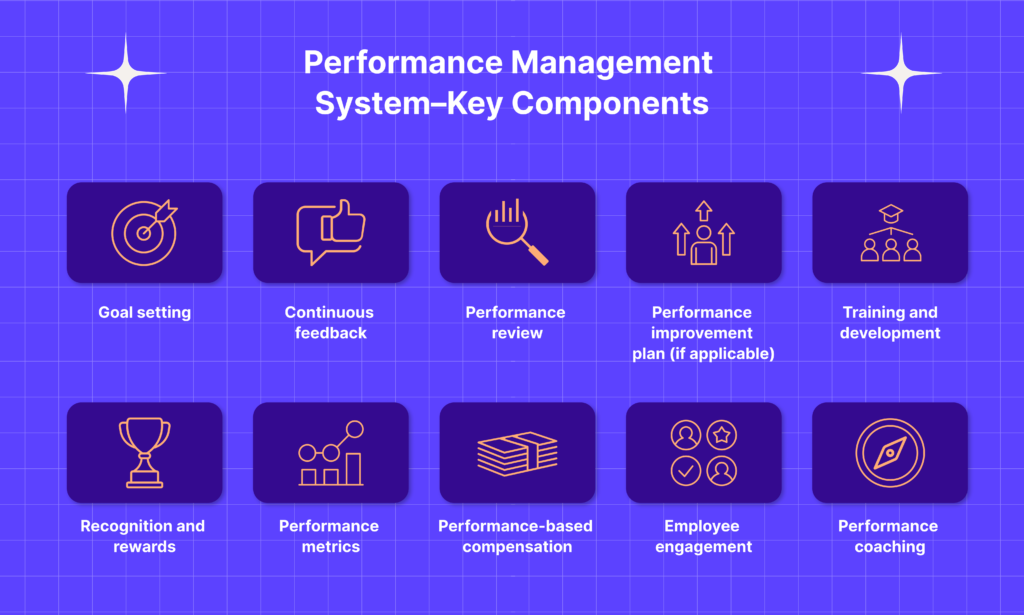What is Performance Management?
Performance management is the process of setting goals, measuring output and providing feedback to improve the performance of a team or individual.
The aim of performance management is to enable employees to contribute their best work to the organization. This is done by creating a culture of continuous feedback and development, where employees feel supported and empowered to succeed.
It is very important for both employees and managers to know all about performance management, the various steps involved in the process and how to improve performance management systems within a business.
Process of Performance Management

Performance management begins with planning and setting expectations. Managers and employees need to have an open, transparent conversation about goals and the performance measurement process.
At the end of this stage, both the manager and employee should be aligned on the goals to be achieved, metrics to be measured and even rewards and recognition to motivate top performance.
Once the goals are set and communicated, performance must be measured against pre-established metrics. Feedback about the employees’ performance must be continuously provided to the employees to help them understand their strengths and areas of improvement.
The next step in the cycle is to conduct a formal performance review. Most companies choose to conduct half-yearly reviews, while some prefer a quarterly cycle.
During these performance reviews, an employees performance and output are discussed and the outcome is either a reward for good work, or a performance improvement plan (PIP).
How to Create a Performance Management System?
The steps in the performance management cycle vary from company to company. Based on the number of employees, the nature of work and the volatility of the industry, businesses must customize the process and establish a robust performance management system.
Here are some tips on creating the best and most effective performance management system.
Performance Management Best Practices:
- Use SMART goals: The goals that are set for employees should be Specific, Measurable, Achievable, Relevant, and Time-bound.
- Involve Employees: Employees should be involved in the performance management process from the beginning. This can help increase engagement and ownership in the process.
- Provide Training: Both, managers and employees need to understand how it works. Providing training can help ensure everyone is on the same page.
- Celebrate Success: Celebrating successes, no matter how small can help motivate employees and reinforce positive behaviours.
Benefits of Performance Management
Performance management has a number of benefits for both employees and organizations.
Benefits for Employees
- Clarity of expectations: Performance management helps employees to understand their role and responsibilities, as well as what is expected of them in terms of performance. This can lead to increased motivation and engagement, as employees know what they are working towards and how their work contributes to the organization’s overall goals.
- Opportunities for development: Performance management should be used to identify employees’ strengths and weaknesses, and to develop a plan for development. This can help employees to reach their full potential and to progress their careers.
- Recognition and reward: Performance management can be used to reward employees for their achievements. This can help to boost morale and motivation, and to create a positive work environment.
Benefits for Organizations
- Improved performance: Performance management helps to ensure that employees are meeting their goals and making valuable contributions to the organization. This can lead to improved productivity, efficiency, and quality.
- Reduced costs: Performance management can help to identify and address areas where the organization is wasting resources or incurring unnecessary costs.
- Increased employee engagement: Performance management can help to create a culture of continuous feedback and development, where employees feel supported and empowered to succeed. This can lead to increased employee engagement and motivation.
- Improved talent retention: Performance management can help to identify and retain top talent. Employees who feel that they are being valued and developed are more likely to stay with the organization.
Automated Performance & Employee Management
RazorpayX Payroll is India’s ONLY fully automated payroll & HR software that calculates and disburses employee salaries automatically. It simplifies manual tasks so that you can focus on strategic work like performance management.
- Direct salary calculations & transfers to employees, interns and contractors
- Automatic filing & payment of compliances like PT, PF, TDS and ESIC
- HR Management from onboarding to exit, powered by Zoho People
- Instant reimbursement claims and payslip generation on WhatsApp
- Exclusive employee insurance plans from Plum at 70% lower costs
FAQs
What is performance management?
Performance management is the process of creating a system for employees to meet their goals and objectives while aligning with the organization's overall mission and vision.
What are the key components of a successful performance management system?
The key components of a successful performance management system include goal-setting, regular check-ins, continuous feedback, and performance evaluations.
How can performance management improve productivity?
Performance management can improve productivity by providing employees with clear expectations, regular feedback, and opportunities for development.
What are some tips for implementing a performance management system?
Some tips for implementing a performance management system include involving employees, providing training, setting realistic goals, and celebrating employee wins.





